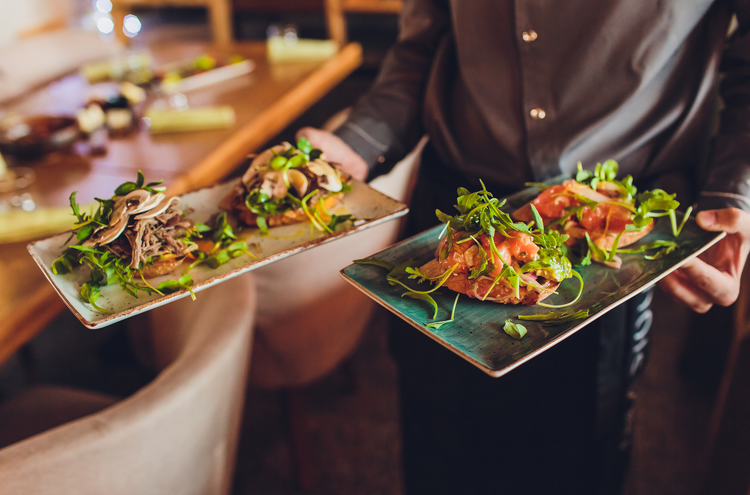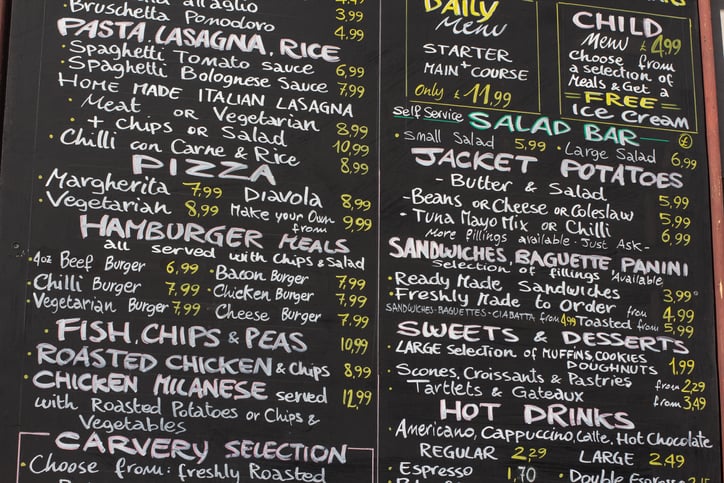This article was updated on December 2, 2022
How to create a restaurant business plan: a step-by-step guide
Already imagining yourself greeting guests as they walk through the doors of your dream restaurant? The smell of the kitchen, the tasteful lighting, the menu? As you take the first steps toward making these dreams a reality you’re going to first need to get all of your ideas down on paper.
What every restaurant needs—before it can get to cooking, selling, and serving—is a solid business plan.
Whether you've built a fine dining establishment or a coffee shop, a carefully crafted restaurant business plan is the essential first course of your journey as a restaurant owner. It’s a multifaceted, guiding document, dedicated to describing every aspect of your proposed restaurant in detail. If you don’t know how to write a business plan, you’re in luck. From financial projections to daily operations, this guide will take you on a step-by-step journey, laying out exactly how to craft a business plan that can bring your culinary vision to life.
The purpose of a business plan
There are many things to consider when learning how to open a restaurant. No matter if you are a big or small business, creating a business plan helps you have an official document that outlines the development of your new establishment. There are essentially three distinct purposes for drafting up a new restaurant business plan:
- Acquiring funding and leasing space
- Pre-planning operations and financial projections to avoid problems
- Displaying your concept for prospective employees and investors
The business plan should be a document you can refer to when opening a restaurant. It’s also a proof of concept that’s necessary to acquire a bank loan or bring on partners and employees.
Because of its multifaceted nature, a business plan needs to be air-tight, well-written, and typically reviewed by legal experts. Use a restaurant business plan template to make sure your business model touches on the necessary requirements, and always consider bringing in an extra set of experienced eyes to read over your plan and add revisions where necessary.
What to include in a restaurant business plan
- Introduction and executive summary
- Business and financial information
- Restaurant concept
- The sample menu
- Marketing strategies
- Daily operations
#1 Introduction and executive summary
The first page of your business plan should outline your main goals and objectives and include a business description. Do you want to make a profit within two years? Are you hoping to gain regional recognition for your menu? This is where you define your restaurant and set your intentions.
When mapping out your business plan, your goal is to persuade the reader that your restaurant idea is viable, whether it’s a potential investor or partner. That means you need to provide them with a clear idea of what to expect and how you’re going to do it.
You’ll be able to go into deeper detail about your business operations throughout the rest of the plan, so keep things simple and direct in your introduction.
When writing the introduction, touch on points such as:
- Brand identity - Who are we and what do we represent? This is the first question you need to ask when beginning your new business. Find inspiration from businesses you like and then differentiate yourself. Your brand identity may seem clear in your mind, but find a way to translate it into your business plan so that anyone reading will find you instantly recognizable. For example, a Norwegian restaurant called Maaemo centers its custom font, menu design, and dining experience around its core philosophy: crafting organic, seasonal, and innovative dishes that are environmentally friendly and creatively inspiring. Each element of the restaurant is a manifestation of this mindset.
- Your concept and why it will work –An executive summary of your concept, and how it can be implemented, is key to this initial section of your business plan. For example, if you’re an experimental Thai fusion restaurant that aims to revolutionize your city’s restaurant scene, you’ll need to explain precisely how. You can also incorporate any market research or brief customer analysis you’ve conducted about your target diners that supports your concept and its success.
- Cost and return on investment – Some of the people reading your plan will likely have a hand (or wallet) in the financial stakes of your business. Convince them it’s a worthwhile endeavor by presenting them with a cumulative cost analysis and a summary of exactly how their investment will be returned.
Remember that this is your chance to make a strong first impression, so push your summary to engage with potential readers in a way that will keep them reading on and encourage them to join you in your culinary venture.
#2 Business and financial information
This is your chance to get into the nitty-gritty of the financial aspects of your restaurant. It is a business, after all, and any successful business requires financial planning and rigorous research.
Break down your various financial sections into specialized sub-categories to bring clarity and readability to your restaurant's financial plan:
- Funding
- Structure
- Target market and competition
Funding
Expand on your summary by detailing specific restaurant ongoing and startup costs, adding up monthly expenditures, conducting financial analysis, and creating a comprehensive budget for your restaurant that includes food, liquor, equipment, and marketing expenses.
You’ll also need to determine your source of funding for start-up costs and the necessary capital needed to keep the business running before it can start turning a profit.
Will Gilson of Puritan & Company in Cambridge, MA, said, “Our construction took so long and had so many financial ‘surprises’ that when we finally received our occupancy, it was a mad dash to get guests in the door to make sure we would have enough money to pay our staff.” So if you can, do your best to plan for those unexpected expenses.
Structure
The legal structure of your business is important to determine before any real purchases can be made. Here are a few options you may consider:
- LLC – This establishes your business as a legal entity, providing it with limited liability and giving it autonomy to exist whether or not the original owners are still involved
- S-Corp – Unlike an LLC, S corporations are not a legal business structure but rather a tax status. However, you will need to register as an LLC before you can file for an S-corp status. This gives small businesses the opportunity to receive certain tax advantages while also opening the door for up to 100 shareholders.
- C-Corp – C corporations exist as a legal entities but will likely face higher taxation. The upside to structuring your business as a C-corp? Unlimited shareholders and the option to reinvest your profits.
If you are unclear on what type of structure is best for your restaurant, a business attorney or tax expert can provide advice as to what type of structure makes the most sense for your business venture.
Target Market and Competition
In order to have a successful restaurant, you will first have to conduct a thorough market analysis and customer analysis. Determine who will be dining at your restaurant. As much as you believe that everyone will love your food, restaurants have specific demographics that they cater to based on:
- Age
- Sex
- Income
- Values
- Hobbies
- Spending habits
- Geographic location
Once you’ve determined what type of potential customers you’re catering to at your establishment, start to research where the overlap is between your customer base and other local restaurants to gauge your competition.
Don’t be discouraged if you’re dealing with a similar demographic as another local business. Guests appreciate variety, and there’s no reason you can’t build a network with other local businesses, turning competition into cooperation.
#3 Restaurant concept
Are you imagining a long, rustic table with a roaring fire behind it, or are you planning on a chic bakery decorated in a modern minimalist fashion? Use the concept section to dive into all your restaurant day-dreaming and turn it into a passionate and exciting basis for what your restaurant will be.
When working on your restaurant concept consider:
- Signage and design choices
- Location
- Interior layout
- Menu design
- Music
- Lighting
- Service style
Restaurants are not only about food—they’re about the experience. Consider the ambiance and theme when developing your restaurant concept. Your customers may be wowed by your dishes, but the right curation of style and atmosphere will make their dining experience unforgettable.
#4 The menu
It should go without saying—the menu is a central item in your business plan. You’ll need to describe your menu in such a way that readers can nearly taste the dishes you cook up on paper. Try to imagine your readers sitting in the best seat in the house with a full-tasting menu in front of them.
In your sample menu section describe aspects such as:
- Flavor profile – Hopefully a tasting will follow shortly, but in the meantime use illustrative and evocative language to build a flavor profile for individual items on your menu. Additionally, explain how items and drinks might pair with each other, where add-ons and up-charges could be added, and what portion sizes to expect. Consider adding images of finely-plated meals to your business plan to give readers a clearer picture.
- Ingredient list and costs – What goes into creating your restaurant’s menu? An ingredient list complete with prices and sources. Demonstrate where money can be saved with shared ingredients between menu items.
#5 Marketing strategies
Advertisement is key to building a local customer base, especially for a new business in the restaurant industry. With the advent of digital market strategies, it opens up another avenue for businesses to get involved directly with their community and customer base.
Use your business plan to explore your marketing plan for:
- Community engagement - Connect with the residents of your community— they’re who you’re serving most. Through community hubs like Nextdoor, you can research what your neighbors are interested in, where they already like to eat, and what they’re missing in terms of local cuisine.
- Digital ad campaigns – Customer loyalty programs, email campaigns, and an easy-to-navigate website can contribute to an effective digital marketing presence. Make sure your online identity aligns with your overall brand values and work to craft campaigns that speak to your target demographic.
- Business networking – As you plan your business, consider other local talents you can connect with. Whether you’re looking to local artists to help with your graphic design, connecting with local news outlets to feature in related articles, or matching up with a community foundation to increase your impact, there are plenty of ways to break bread before you’ve even opened your doors.
#6 Daily operations
How do you imagine your restaurant running when it’s finally open? From payment procedures to the chain of command, it’s important to have a handle on the daily operations of your new enterprise.
Touch on aspects such as:
- Hiring and staffing – How many servers will you need on the floor? What kind of back-of-the-house staff do you anticipate needing? When imagining how your restaurant will be run, you’ll need to imagine who is there. Consider management options and hiring practices so that when the time comes to bring on new team members, you’ll have an easier time picking the right ones for your restaurant.
- Your business experience - Describe your management experience in former positions and demonstrate how you would form the management team. Potential investors would love to know what kind of experience you are equipped with to execute your restaurant operation plans.
- Hours of operation – Whether you’re all-day, seven nights a week, or just planning on catering to the brunch crowd, consider what days you’ll be open and for how long. This will also impact how many shifts you’ll need to staff for and allow you to imagine what a typical schedule could look like for your employees.
The longer you choose to be open, the higher operating costs will become. As Mike Corwin, owner of Waverly Ohio’s Diner 23 says, “Taking in a lot of money doesn't help if you're spending more than you bring in."
No matter how much planning you do, there will always be unexpected challenges when it comes to opening a restaurant, so be flexible once everything is up and running.
Building a better business with Nextdoor
After building your business plan, you’ll be ready to tackle the next challenge of bringing those plans to life. Before you begin, you might look to your neighbors for a little advice.
With Nextdoor, you can connect with potential customers in the neighborhoods that you’ll be serving and join a community of diverse locals. Nextdoor is about empowering local businesses to communicate with their neighbors to weave a tightly knit circle of trust and respect between business owners and their customers.
Join the neighborhood with Nextdoor today.








